News
-
New insight in atomic permeation through a defective carbon lattice
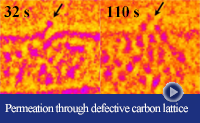 September 12, 2020 - Permeation and transport of atoms, molecules or ions across membranes is one of the most fundamental phenomena in natural and manmade materials. A team of scientists from the Universities in Ulm, Germany and Nottingham, UK has directly imaged the permeation process of Pd atoms across a defect in a carbon lattice.
September 12, 2020 - Permeation and transport of atoms, molecules or ions across membranes is one of the most fundamental phenomena in natural and manmade materials. A team of scientists from the Universities in Ulm, Germany and Nottingham, UK has directly imaged the permeation process of Pd atoms across a defect in a carbon lattice.
-
Formation of crystals filmed in atomic detail
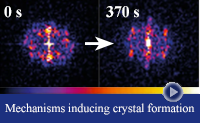 August 28, 2020 - A team of scientists from Germany, UK and Japan shed light on the fundamental phenomenon of nucleation and crystal growth. The direct observation of the entire process of nucleation allowed to distinguish the point at which the particles were large enough to become crystalline.
August 28, 2020 - A team of scientists from Germany, UK and Japan shed light on the fundamental phenomenon of nucleation and crystal growth. The direct observation of the entire process of nucleation allowed to distinguish the point at which the particles were large enough to become crystalline.
-
Atomic probe of bond dynamics and reactivity of individual HF and H2O atoms
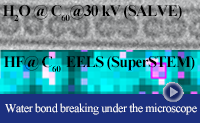 August 20, 2020 - A new study of scientists from the Universities of Ulm (Germany), Nottingham (UK), Southampton (UK) and Leeds (UK) enable bond dynamics and reactivity studies of H2O and HF at the single-molecule level. The atomic scale study was conducted at low and very low primary energies of 30 - 80 keV in the SALVE microscope and 60 keV in the SuperSTEM microscope by entrapping HF and H2O molecules within fullerene C60 cages in nanotubes.
August 20, 2020 - A new study of scientists from the Universities of Ulm (Germany), Nottingham (UK), Southampton (UK) and Leeds (UK) enable bond dynamics and reactivity studies of H2O and HF at the single-molecule level. The atomic scale study was conducted at low and very low primary energies of 30 - 80 keV in the SALVE microscope and 60 keV in the SuperSTEM microscope by entrapping HF and H2O molecules within fullerene C60 cages in nanotubes.
-
Pioneers of electron microscopy receive the Kavli Prize
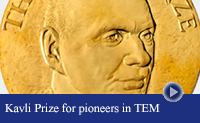 May 27, 2020 - The Norwegian Academy of Sciences awards the Kavli Prize for Nanosciences 2020 to Harald H. Rose (University Ulm and Darmstadt), Maximilian Haider (CEOS, Heidelberg), Knut W. Urban (Research Center Jülich) and Ondrej L. Krivanek (Nion, Kirkland) "for sub-Ångström resolution imaging and chemical analysis using electron beams“.
May 27, 2020 - The Norwegian Academy of Sciences awards the Kavli Prize for Nanosciences 2020 to Harald H. Rose (University Ulm and Darmstadt), Maximilian Haider (CEOS, Heidelberg), Knut W. Urban (Research Center Jülich) and Ondrej L. Krivanek (Nion, Kirkland) "for sub-Ångström resolution imaging and chemical analysis using electron beams“.
-
Influence of defects on proton and Li-Ion permeation through graphene
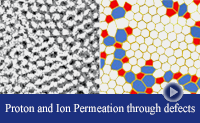 May 19, 2020 - In a new study, researchers from the Universities of Manchester, Antwerpen, Ulm, Jena, Singapore and Tokyo as well as from the Chinese Academy of Sciences further explore graphene membranes as protective barriers in various Li-ion and hydrogen technologies.
May 19, 2020 - In a new study, researchers from the Universities of Manchester, Antwerpen, Ulm, Jena, Singapore and Tokyo as well as from the Chinese Academy of Sciences further explore graphene membranes as protective barriers in various Li-ion and hydrogen technologies.
-
Defect formation in two-dimensional MoS2 in very low voltage TEM likely caused by electronic excitations
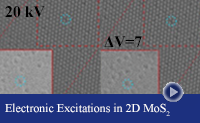 March 20, 2020 - The role of electronic excitations for defect production at electron energies below the knock-on threshold is a long-standing question. Using a combination of atomically resolved data from the SALVE TEM and theoretical calculation researchers from the Helmholtz-Zentrum Dresden-Rossendorf and Ulm University revealed a new mechanism of defect formation below the knock-on threshold.
March 20, 2020 - The role of electronic excitations for defect production at electron energies below the knock-on threshold is a long-standing question. Using a combination of atomically resolved data from the SALVE TEM and theoretical calculation researchers from the Helmholtz-Zentrum Dresden-Rossendorf and Ulm University revealed a new mechanism of defect formation below the knock-on threshold.
-
Chemical bond making and breaking recorded in action
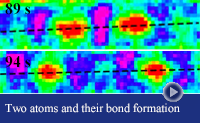 Januar 17, 2020 - A research team from the Germany and the UK has for the first time filmed chemical bonds to break and to form, with spatiotemporal continuity, in real time. The team observed that the two rhenium atoms are bonded mainly through a quadruple bond, providing new fundamental insights into transition metal chemistry.
Januar 17, 2020 - A research team from the Germany and the UK has for the first time filmed chemical bonds to break and to form, with spatiotemporal continuity, in real time. The team observed that the two rhenium atoms are bonded mainly through a quadruple bond, providing new fundamental insights into transition metal chemistry.
-
Crystalline quality of MoS2 from atomic resolution microscopy
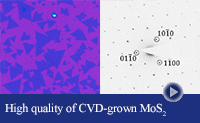 November 04, 2019 - A group of researchers from the Universities Toulouse (France), Jena and Ulm (Germany) and the National Institute for Materials Science Tsukubathe (Japan) showed that conventional CVD MoS2 monolayers possess high optical quality.
November 04, 2019 - A group of researchers from the Universities Toulouse (France), Jena and Ulm (Germany) and the National Institute for Materials Science Tsukubathe (Japan) showed that conventional CVD MoS2 monolayers possess high optical quality.
-
Crystallinity and atomic structure of nanoporous graphene
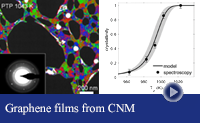 May 22, 2019 - In a new study, researchers from Germany prodcued graphene with tunable crystallinity and porosity. Combined dark-field TEM and electron diffraction data confirmed the crystallinity of the composite material in agreement with a detailed crystallization model. The AC-HRTEM data revealed the excellent quality of the produced graphene.
May 22, 2019 - In a new study, researchers from Germany prodcued graphene with tunable crystallinity and porosity. Combined dark-field TEM and electron diffraction data confirmed the crystallinity of the composite material in agreement with a detailed crystallization model. The AC-HRTEM data revealed the excellent quality of the produced graphene.
-
Visualization of unstained DNA nanostructures at 20 kV
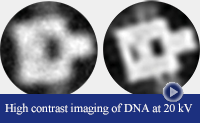 May 10, 2019 - TEM visualization of individual DNA molecules in its native unlabeled form has remained extremely challenging. A team of scientists now compared different strategies to obtain high contrast: Cs/Cc corrected microscopy at very low primary energies, volta-potential phase plate microscopy, and dark-field microscopy.
May 10, 2019 - TEM visualization of individual DNA molecules in its native unlabeled form has remained extremely challenging. A team of scientists now compared different strategies to obtain high contrast: Cs/Cc corrected microscopy at very low primary energies, volta-potential phase plate microscopy, and dark-field microscopy.
-
Towards Quantum Devices: Single-Layer TMD's under the electron beam.
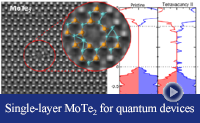 April 26, 2019 - Control of optical, magnetic and electronic properties of two-dimensional materials in MoTe2 is an intersting approach to create new quantum devices. Using 40 kV Cs/Cc corrected TEM, scientists now gained insights into the formation and evolution of quantum dots and other nanoscale morphologies.
April 26, 2019 - Control of optical, magnetic and electronic properties of two-dimensional materials in MoTe2 is an intersting approach to create new quantum devices. Using 40 kV Cs/Cc corrected TEM, scientists now gained insights into the formation and evolution of quantum dots and other nanoscale morphologies.
-
Observation of lithiated graphene membranes
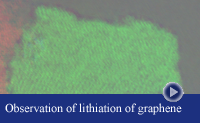 December 02, 2018 - The study of the charging of a battery at atomic resolution is an advance that promises the ability to inspire the design of future carbon-based energy storage systems. The process has now been observed at the atomic level with the in situ TEM SALVE.
December 02, 2018 - The study of the charging of a battery at atomic resolution is an advance that promises the ability to inspire the design of future carbon-based energy storage systems. The process has now been observed at the atomic level with the in situ TEM SALVE.
-
Private life of nanoclusters
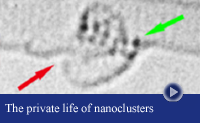 September 09, 2018 - A new study examining transition metals in carbon nanotubes and published today in Nature Communications was carried out in the Group of Electron Microscopy for Materials Science at Ulm University.
September 09, 2018 - A new study examining transition metals in carbon nanotubes and published today in Nature Communications was carried out in the Group of Electron Microscopy for Materials Science at Ulm University.
-
Chemical graphene synthesis understood
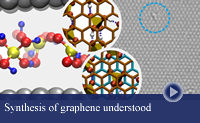 March 15, 2018 - Researchers from Free University Berlin, University Erlangen-Nürnberg and Ulm University have defined the mechanism on which chemical synthesis of graphene from graphite is based.
March 15, 2018 - Researchers from Free University Berlin, University Erlangen-Nürnberg and Ulm University have defined the mechanism on which chemical synthesis of graphene from graphite is based.
-
Third SALVE Symposium 2017
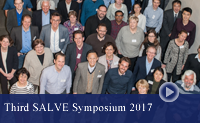 December 12, 2017 - The 3rd SALVE Symposium brings together distinguished scientists from 17 countries to discuss low-voltage instrumentation and its applications.
December 12, 2017 - The 3rd SALVE Symposium brings together distinguished scientists from 17 countries to discuss low-voltage instrumentation and its applications.
-
Ceremony for the inauguration of the SALVE microscope
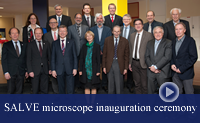 December 11, 2017 - SALVE members, funding agencies, the presidents of the national, European and international microscopy societies, as well as the president of the University of Ulm celebrate the inauguration of the SALVE microscope in its purpose-made building.
December 11, 2017 - SALVE members, funding agencies, the presidents of the national, European and international microscopy societies, as well as the president of the University of Ulm celebrate the inauguration of the SALVE microscope in its purpose-made building.
-
The SALVE microscope comes home
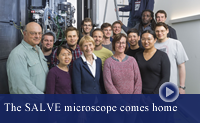 September 29, 2017 - There is something to celebrate at Ulm University: the SALVE microscope comes home! The new microscope building has been completed on time for the move.
September 29, 2017 - There is something to celebrate at Ulm University: the SALVE microscope comes home! The new microscope building has been completed on time for the move.
-
Nanobubbles and crystal growth monitored in graphene pockets
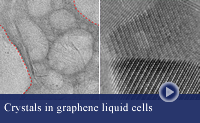 July 24, 2017 - Ulm University physicists and biologists enhance the understanding of dynamics and internal conditions of liquids encapsulated between two graphene sheets. By filming the "graphene liquid cells" they were able to identify constituents of the fluid and thus study the interior pressure and temperature conditions.
July 24, 2017 - Ulm University physicists and biologists enhance the understanding of dynamics and internal conditions of liquids encapsulated between two graphene sheets. By filming the "graphene liquid cells" they were able to identify constituents of the fluid and thus study the interior pressure and temperature conditions.
-
Caught on camera: Chemical reactions 'filmed' at the single-molecule level
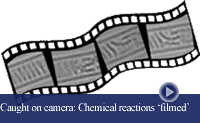 March 28, 2017 - Chemists around the world look forward to seeing chemical transformations at the single-molecule level. Now an international team of scientists has published a paper about their observation of two chemical reactions with molecules of similar size and shape but with different chemical composition: octathi[8]circulene (OCT) and perchlorocoronene (PCC) which they caught on camera with atomic resolution using their new method named chemTEM.
March 28, 2017 - Chemists around the world look forward to seeing chemical transformations at the single-molecule level. Now an international team of scientists has published a paper about their observation of two chemical reactions with molecules of similar size and shape but with different chemical composition: octathi[8]circulene (OCT) and perchlorocoronene (PCC) which they caught on camera with atomic resolution using their new method named chemTEM.
-
New endohedral metallo-fullerenes
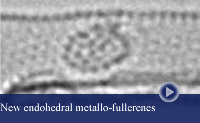 January 11, 2017 - The electron microscope is used not only to image chemical reactions with atomic resolution, but also to initiate these reactions. An international team of scientists has demonstrated the synthesis of new endohedral metallofullerenes (EMFs) within CNT. The study was carried out in the context of the SALVE project in the aberration-corrected high-resolution electron microscope (HRTEM).
January 11, 2017 - The electron microscope is used not only to image chemical reactions with atomic resolution, but also to initiate these reactions. An international team of scientists has demonstrated the synthesis of new endohedral metallofullerenes (EMFs) within CNT. The study was carried out in the context of the SALVE project in the aberration-corrected high-resolution electron microscope (HRTEM).
-
Vibrational properties of 2D silica and kagome lattice materials
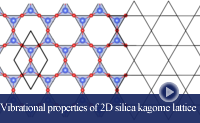 November 9, 2016 - Little is known about vibrational properties of two-dimensional silica (2D-SiO2) and its Raman spectrum. A study by European scientists with contribution of the SALVE project, now identified several previously uncharacterized vibrational states of 2D-SiO2. At finite temperatures, the stability of the lattice is strongly influenced by phonon-phonon interaction, the study finds. It provides insights into 2D-silicas lattice type in general and also suggests a quick nondestructive method to detect 2D silica.
November 9, 2016 - Little is known about vibrational properties of two-dimensional silica (2D-SiO2) and its Raman spectrum. A study by European scientists with contribution of the SALVE project, now identified several previously uncharacterized vibrational states of 2D-SiO2. At finite temperatures, the stability of the lattice is strongly influenced by phonon-phonon interaction, the study finds. It provides insights into 2D-silicas lattice type in general and also suggests a quick nondestructive method to detect 2D silica.
-
SALVE Cs/Cc-correction realized
 August 09, 2016 - By pushing the usable aperture to the highest value ever reached in phase-contrast TEM imaging, the SALVE project completes the list of atomic-resolution TEMs. The SALVE III TEM operates in the range between 20 to 80 kV obtaining a resolution limit as small as 15 wavelenghts which is more than six times smaller than that of uncorrected TEMs.
August 09, 2016 - By pushing the usable aperture to the highest value ever reached in phase-contrast TEM imaging, the SALVE project completes the list of atomic-resolution TEMs. The SALVE III TEM operates in the range between 20 to 80 kV obtaining a resolution limit as small as 15 wavelenghts which is more than six times smaller than that of uncorrected TEMs.
-
Carbon nanotubes as electrically active nanoreactors for multi-step inorganic synthesis
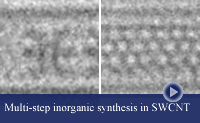 June 03, 2016 - Scientists from UK, Germany and Japan report that they both have performed the first inorganic synthesis with well-defined clusters as reaction products as well as for the first time carried out a 2-step synthesis in a CNT. With a further improvement of the technology necessary to extract the reaction products from CNT, these methods can provide significant contributions to the synthesis of compounds for e. g. catalysis and electronic devices.
June 03, 2016 - Scientists from UK, Germany and Japan report that they both have performed the first inorganic synthesis with well-defined clusters as reaction products as well as for the first time carried out a 2-step synthesis in a CNT. With a further improvement of the technology necessary to extract the reaction products from CNT, these methods can provide significant contributions to the synthesis of compounds for e. g. catalysis and electronic devices.
-
A milestone of microscopy history: The SALVE III microscope is completed and reaches a new world record
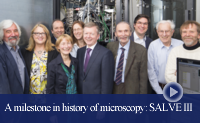 April 25, 2016 - Ulm University, FEI Company and CEOS GmbH announced today that they have finalized the SALVE III microscope. "We are truly excited by the successful completion which surpassed all our expectations the more since the SALVE microscope is the first of its kind. Our long-lasting efforts have paid off,” said Ute Kaiser, University of Ulm, head of the SALVE project.
April 25, 2016 - Ulm University, FEI Company and CEOS GmbH announced today that they have finalized the SALVE III microscope. "We are truly excited by the successful completion which surpassed all our expectations the more since the SALVE microscope is the first of its kind. Our long-lasting efforts have paid off,” said Ute Kaiser, University of Ulm, head of the SALVE project.
-
Benefits and limitations of low-kV macromolecular imaging for cryo-microscopy
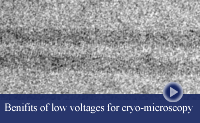 February 23, 2016 - Researchers have long been trying to develop technologies that improve the resolution for biological samples embedded in ice ("Cryo-Microscopy"). Could low-voltage high-resolution electron microscopy, which enabled imaging of 2-dimensional materials with atomic resolution, lead also here to a quantum leap?
February 23, 2016 - Researchers have long been trying to develop technologies that improve the resolution for biological samples embedded in ice ("Cryo-Microscopy"). Could low-voltage high-resolution electron microscopy, which enabled imaging of 2-dimensional materials with atomic resolution, lead also here to a quantum leap?
-
AC-HRTEM as a new tool to study chemical reactions of carbon and metals
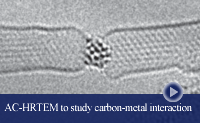 February 05, 2016 - In a new study conducted in the frame of the SALVE project, scientists have investigated the bonds between carbon and group VIII metals on an atomic scale. The study also provides new insights into radiation damage processes occurring in the presence of carbon and metal compounds under electron beam of irradiation.
February 05, 2016 - In a new study conducted in the frame of the SALVE project, scientists have investigated the bonds between carbon and group VIII metals on an atomic scale. The study also provides new insights into radiation damage processes occurring in the presence of carbon and metal compounds under electron beam of irradiation.
-
Beam Down in the SALVE III/TITAN Microscope
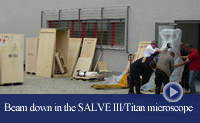 July 24, 2015 - This Friday, one milestone of the SALVE III project was reached: the SALVE III/TITAN has been handled over from FEI Electron Optics to CEOS company, after the beam traveled down the column with the SALVE++ Cc/Cs corrector installed.
July 24, 2015 - This Friday, one milestone of the SALVE III project was reached: the SALVE III/TITAN has been handled over from FEI Electron Optics to CEOS company, after the beam traveled down the column with the SALVE++ Cc/Cs corrector installed.
-
Microstructure and properties of Se-deficient 2D MoSe2
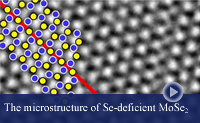 March 24, 2015 - Se-deficit in single layers of MoSe2 grown by molecular beam epitaxy gives rise to a dense network of mirror-twin-boundaries (MTBs) decorating the 2D-grains, according to a new study by a team of researchers led by the group of electron microscopy for materials science (EMMS).
March 24, 2015 - Se-deficit in single layers of MoSe2 grown by molecular beam epitaxy gives rise to a dense network of mirror-twin-boundaries (MTBs) decorating the 2D-grains, according to a new study by a team of researchers led by the group of electron microscopy for materials science (EMMS).
-
FEI company joins the SALVE project
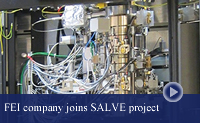 March 16, 2015 - FEI company joins University of Ulm and CEOS company in the SALVE project. This step initiates the third phase of the SALVE project to develop a sub-Ångström low-voltage electron microscope with improved contrast andreduced damage on bio-molecules and two dimensional nanomaterials.
March 16, 2015 - FEI company joins University of Ulm and CEOS company in the SALVE project. This step initiates the third phase of the SALVE project to develop a sub-Ångström low-voltage electron microscope with improved contrast andreduced damage on bio-molecules and two dimensional nanomaterials.
-
Bottom-up formation of robust gold carbide
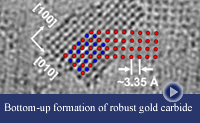 March 16, 2015 - In experiments involving the heating of graphene decorated with gold particles in the electron microscope, scientists discovered little crystals with quadratic arrangements which had a larger lattice constant than pure gold clusters. The Repeated heating of up to 1000 K allowed reproduction of the structure. As the scientists reported, it is a material that has never been synthesized in such a large quantity and stability until now: gold carbide. For their analysis they combined aberration-corrected high-resolution transmission electron microscopy (AC-HRTEM) with density-functional theory calculations (DFT).
March 16, 2015 - In experiments involving the heating of graphene decorated with gold particles in the electron microscope, scientists discovered little crystals with quadratic arrangements which had a larger lattice constant than pure gold clusters. The Repeated heating of up to 1000 K allowed reproduction of the structure. As the scientists reported, it is a material that has never been synthesized in such a large quantity and stability until now: gold carbide. For their analysis they combined aberration-corrected high-resolution transmission electron microscopy (AC-HRTEM) with density-functional theory calculations (DFT).
-
SALVE Symposium 2015
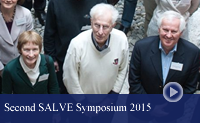 February 17-18, 2015 - Scientists from 16 countries met in Ulm, Germany for the Second SALVE Symposium 2015.
February 17-18, 2015 - Scientists from 16 countries met in Ulm, Germany for the Second SALVE Symposium 2015.
-
Physical Colloquium to honor Harald Rose on the occasion of his 80th birthday
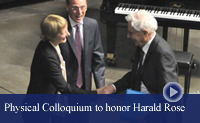 February 16, 2015 - On the occasion of Harald Rose's 80th birthday a physical colloquium was held at Ulm University..
February 16, 2015 - On the occasion of Harald Rose's 80th birthday a physical colloquium was held at Ulm University..
-
Graphene at supersaturation enables observation of implanted self-interstitials
 January 14, 2015 - Researchers from the group of Electron Microscopy of Materials Science at the University of Ulm with the principle investigator Ossi Lehtinen under the direction of Ute Kaiser succeeded for the first time to image implanted self-interstitials at the example of the material graphene.
January 14, 2015 - Researchers from the group of Electron Microscopy of Materials Science at the University of Ulm with the principle investigator Ossi Lehtinen under the direction of Ute Kaiser succeeded for the first time to image implanted self-interstitials at the example of the material graphene.
-
First observation of boron nitride chains
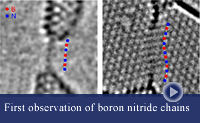 December 01, 2014 - A research team from Japan, Finland and Germany under the direction of Kazu Suenaga, Arkady V. Krasheninnikov and Ute A. Kaiser has experimentally for the first time produced and observed boron nitride atomic chains using a transmission electron microscope.
December 01, 2014 - A research team from Japan, Finland and Germany under the direction of Kazu Suenaga, Arkady V. Krasheninnikov and Ute A. Kaiser has experimentally for the first time produced and observed boron nitride atomic chains using a transmission electron microscope.
-
Ultramicroscopy highlights Low-Voltage Electron Microscopy by a special issue
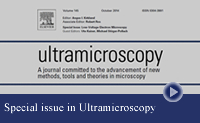 October 12, 2014 - Ultramicroscopy devotes a special issue to low-voltage electron microscopy. Guest editors are Ute Kaiser and Michael Stöger-Pollach. We present here furthermore a detailed evaluation of our aberration-corrected TEM data basis on (1) which topics are generally represented in the high-impact factor journal and (2) on the potential of imaging of biological objects.
October 12, 2014 - Ultramicroscopy devotes a special issue to low-voltage electron microscopy. Guest editors are Ute Kaiser and Michael Stöger-Pollach. We present here furthermore a detailed evaluation of our aberration-corrected TEM data basis on (1) which topics are generally represented in the high-impact factor journal and (2) on the potential of imaging of biological objects.
-
Non-invasive electron microscopy reveals structure of proton-irradiated graphene
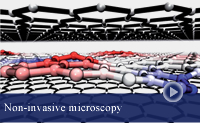 June 21, 2014 - A novel method for non-invasive imaging of vacancy defects in graphene by high-resolution transmission electron microscopy is demonstrated and used to show that ion irradiation of graphene produces reconstructed monovacancies.
June 21, 2014 - A novel method for non-invasive imaging of vacancy defects in graphene by high-resolution transmission electron microscopy is demonstrated and used to show that ion irradiation of graphene produces reconstructed monovacancies.
-
A new two-dimensional graphitic semiconductor: Carbon nitride
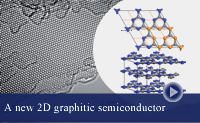 May 18, 2014 - A European team consisting of nine groups from UK, Germany and Finland demonstrate two-dimensional carbon nitride for the first time.
May 18, 2014 - A European team consisting of nine groups from UK, Germany and Finland demonstrate two-dimensional carbon nitride for the first time.
-
TEM images allow further insights into the atomic structure of vitreous carbon networks
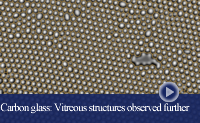 February 11, 2014 - In a new study, published in the journal "Scientific reports" from the Nature publishing group, researchers explore further the atomic structure of glass.
February 11, 2014 - In a new study, published in the journal "Scientific reports" from the Nature publishing group, researchers explore further the atomic structure of glass.
-
ZEISS to leave the SALVE project: Future of SALVE is secured
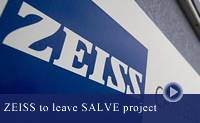 February 06, 2014 - ZEISS will leave the SALVE project in the wake of the decision to focus the electron microscopy branch on Scanning Electron Microscopy (SEM) Technology.
February 06, 2014 - ZEISS will leave the SALVE project in the wake of the decision to focus the electron microscopy branch on Scanning Electron Microscopy (SEM) Technology.
-
BBVA Foundation Frontiers of Knowledge Award 2013: Rose, Haider and Urban
 January 30, 2014 - The award goes to physicists Harald Rose, Maximilian Haider and Knut Urban for greatly enhancing the resolving power of electron microscopy by developing aberration-corrected electron optics, a breakthrough enabling subatomic precision.
January 30, 2014 - The award goes to physicists Harald Rose, Maximilian Haider and Knut Urban for greatly enhancing the resolving power of electron microscopy by developing aberration-corrected electron optics, a breakthrough enabling subatomic precision.
-
Defects in bilayer silica and graphene: Common trends in diverse hexagonal 2D systems
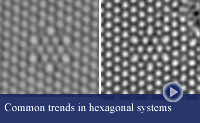 December 16, 2013 - Through a combination of aberration corrected high-resolution transmission electron microscopy (HRTEM) with density functional theory (DFT) and classical force field (CFF) calculations, an international team of scientists with the participation of the SALVE project has investigated how the symmetries of the crystal lattice determine defects and grain boundaries.
December 16, 2013 - Through a combination of aberration corrected high-resolution transmission electron microscopy (HRTEM) with density functional theory (DFT) and classical force field (CFF) calculations, an international team of scientists with the participation of the SALVE project has investigated how the symmetries of the crystal lattice determine defects and grain boundaries.
-
Watching silica's dance: Imaging the atomic arrangements in glass
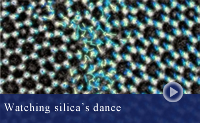 November 25, 2013 - By the use of the electron beam of a low-voltage aberration-corrected high-resolution transmission electron microscope, a detailed picture of a two-dimensional glass on the atom-by-atom level could be obtained.
November 25, 2013 - By the use of the electron beam of a low-voltage aberration-corrected high-resolution transmission electron microscope, a detailed picture of a two-dimensional glass on the atom-by-atom level could be obtained.
-
Encapsulation of MoS2 in graphene: controlling radiation damage
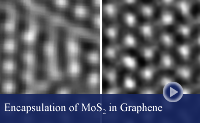 October/November, 2013 - The radiation damage in MoS2 under the electron beam at electron energies of 60 and 80 keV can be largely avoided by encapsulation between 2 graphene layers. As two groups of researchers at the University of Manchester in collaboration with the SuperSTEM laboratory (both UK) and at the University of Ulm (Germany) independently and consistently reported, the radiation damage in the beam-sensitive 2-dimensional transistion metal dichalgonide (TMD) is reduced by several orders of magnitude.
October/November, 2013 - The radiation damage in MoS2 under the electron beam at electron energies of 60 and 80 keV can be largely avoided by encapsulation between 2 graphene layers. As two groups of researchers at the University of Manchester in collaboration with the SuperSTEM laboratory (both UK) and at the University of Ulm (Germany) independently and consistently reported, the radiation damage in the beam-sensitive 2-dimensional transistion metal dichalgonide (TMD) is reduced by several orders of magnitude.
-
First SALVE Symposium on the occasion of Ute Kaiser’s 60th birthday
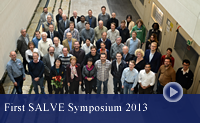 October 14-15, 2013 - More than 50 scientists met in Ulm, Germany for the Physical Colloquium and Reception on the occasion of Ute Kaiser’s 60th birthday and the international SALVE Discussion Meeting.
October 14-15, 2013 - More than 50 scientists met in Ulm, Germany for the Physical Colloquium and Reception on the occasion of Ute Kaiser’s 60th birthday and the international SALVE Discussion Meeting.
-
Dislocations in graphene: The importance of 3D buckling
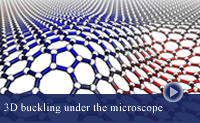 June 28, 2013 - The birth and death of a dislocation - its full life cycle is captured by low-voltage aberration corrected high-resolution TEM. We discuss the role of dislocations and the central importance of the 3D buckling calculation for graphene research.
June 28, 2013 - The birth and death of a dislocation - its full life cycle is captured by low-voltage aberration corrected high-resolution TEM. We discuss the role of dislocations and the central importance of the 3D buckling calculation for graphene research.
-
Atomistic description of electron beam damage mechanisms in single-walled carbon nanotubes and N-doped graphene
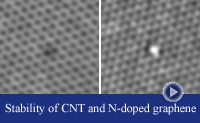 September 24, 2012 - A team of scientists from 6 European countries, including the the Universities of Aalto, Vienna, Helsinki, and Ulm, the Institute of Nanoscience of Aragon, the Laboratory for Microstructural Investigations Chatillon, and the Max Planck Institute for Solid State Research Stuttgart, has combined STEM, HRTEM, and computational methods to study the electron beam damage in carbon nanotubes and graphene with nitrogen dopants.
September 24, 2012 - A team of scientists from 6 European countries, including the the Universities of Aalto, Vienna, Helsinki, and Ulm, the Institute of Nanoscience of Aragon, the Laboratory for Microstructural Investigations Chatillon, and the Max Planck Institute for Solid State Research Stuttgart, has combined STEM, HRTEM, and computational methods to study the electron beam damage in carbon nanotubes and graphene with nitrogen dopants.
-
Scientists calculate displacement threshold for two-dimensional atomic crystals
 July 17, 2012 - Scientists from the Universities Helsinki and Aalto in Finland, the University of Ulm in Germany and of Vienna in Austria studied the behavior of 21 representative two-dimensional atomic crystals under electron irradiation by employing first-principle simulations and compared their results in the case of MoS2 with experimental data on the production of vacancies in HR-TEM images. The study provides insights into the effects of electron irradiation on TMDs and the modification of their physical properties about which very little is known today.
July 17, 2012 - Scientists from the Universities Helsinki and Aalto in Finland, the University of Ulm in Germany and of Vienna in Austria studied the behavior of 21 representative two-dimensional atomic crystals under electron irradiation by employing first-principle simulations and compared their results in the case of MoS2 with experimental data on the production of vacancies in HR-TEM images. The study provides insights into the effects of electron irradiation on TMDs and the modification of their physical properties about which very little is known today.
-
Accurate measurement of knock-on damage in graphene
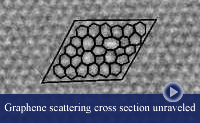 May 07, 2012 - Radiation damage resulting from the collision of a beam electron with an atomic nucleus (Knock-on damage) is a problem with which electron microscopists must deal every day when imaging sensitive materials. It is generally known that the imaging of graphene requires acceleration voltages ≤ 80 kV. In spite of its great importance, a comprehensive quantitative analysis is missing among the studies published so far. The new study now closes this gap and also unravels the underlying physical processes.
May 07, 2012 - Radiation damage resulting from the collision of a beam electron with an atomic nucleus (Knock-on damage) is a problem with which electron microscopists must deal every day when imaging sensitive materials. It is generally known that the imaging of graphene requires acceleration voltages ≤ 80 kV. In spite of its great importance, a comprehensive quantitative analysis is missing among the studies published so far. The new study now closes this gap and also unravels the underlying physical processes.
-
New Trend in Electron Microscopy: Aberration-Corrected Low Voltage TEM
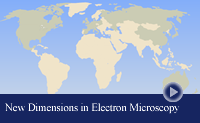 May 03, 2012 - A study examines the global research activities in the new field of hardware aberration-corrected low-voltage electron microscopy.
May 03, 2012 - A study examines the global research activities in the new field of hardware aberration-corrected low-voltage electron microscopy.
-
The transformation of carbon adsorbates on graphene under extreme heat
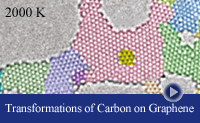 October 24, 2011 - A new study unravels the transformation of carbon adsorbates on graphene into amorphous or crystalline carbon monolayers at extremely high temperatures.
October 24, 2011 - A new study unravels the transformation of carbon adsorbates on graphene into amorphous or crystalline carbon monolayers at extremely high temperatures.
-
Wolf-Prize 2011 for Aberration-Correction: A Breakthrough in Electron Microscopy
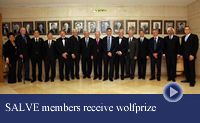 May 29, 2011 - Three German physicists, Harald H. Rose (UUlm, SALVE member), Maximillian Haider (CEOS company, SALVE member) and Knut W. Urban (Ruska Centre Jülich) have received the Wolf-prize 2011 in physics.
May 29, 2011 - Three German physicists, Harald H. Rose (UUlm, SALVE member), Maximillian Haider (CEOS company, SALVE member) and Knut W. Urban (Ruska Centre Jülich) have received the Wolf-prize 2011 in physics.
-
Charges under the microscope
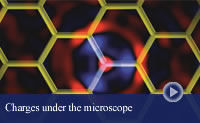 March 16, 2011 - Experimental and theoretical studies reveal that TEM can resolve charge transfer due to chemical bonds.
March 16, 2011 - Experimental and theoretical studies reveal that TEM can resolve charge transfer due to chemical bonds.
-
Green Light for SALVE Phase II
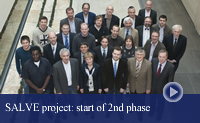 February, 2011 - SALVE Team received green light from sponsors DFG and the Baden Württemberg Ministry for Science, Research and Art (MWK).
February, 2011 - SALVE Team received green light from sponsors DFG and the Baden Württemberg Ministry for Science, Research and Art (MWK).
-
SALVE I-II consultant Harald H. Rose at Ulm University
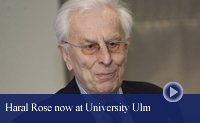 June 01, 2010 - Harald H. Rose, the inventor of the practical realizable aberration correction at Ulm University today.
June 01, 2010 - Harald H. Rose, the inventor of the practical realizable aberration correction at Ulm University today.
-
Fullerenes to form directly out of graphene
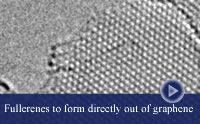 May 09, 2010 - A detailed observation of the dynamic transformations of graphene published today show unambigously that close-cage fullerene structures are formed directly from flat sheets of graphene.
May 09, 2010 - A detailed observation of the dynamic transformations of graphene published today show unambigously that close-cage fullerene structures are formed directly from flat sheets of graphene.
-
Scientists to observe chemical reactions in real time and atomic space
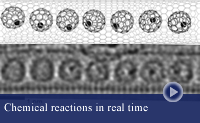 November 26, 2009 - The AC-HR-TEM technique may ultimately improve the understanding of chemical reactions.
November 26, 2009 - The AC-HR-TEM technique may ultimately improve the understanding of chemical reactions.
-
Stable carbon chains to form via simple routes from graphene nano-bridges
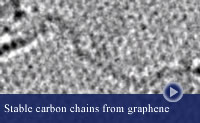 August 19, 2009 - A new study finds that an exotic carbon allotrope is created due to preferred electron beam-induced chemical etching of a graphene nano-bridge.
August 19, 2009 - A new study finds that an exotic carbon allotrope is created due to preferred electron beam-induced chemical etching of a graphene nano-bridge.
Press Releases
-
Nature Research "From Chaos to Order"

September 01, 2020 - In a "Behind the Paper" post for Nature Research Chemistry Community, Dr. Kecheng Cao describes the filming of the nucleation of metal from single atoms.
-
LABORPRAXIS "Atomic Lego or Particle Chaos?"

September 01, 2020 - A press articles on laborpraxis.vogel.de reports on the first observation of the earliest stage of crystallization.
-
The Kavli Foundation Kavli Prize in Nanoscience 2020

May 14, 2020 - The Kavli Prize in Nanoscience is awarded to four scientists for their research and inventions of aberration-corrected lenses in electron microscopes: Harald H. Rose from the Group of Electron Microscopy for Materials Science at Ulm University and the Technical University of Darmstadt, Maximilian Haider from CEOS GmbH, Knut Urban from the Forschungszentrum Jülich, and Ondrej L Krivanek from Nion Co.
-
Altmetric.de "First-ever video of atoms bonding together"

February 18, 2020 - A new article by Cao et al. has received an Altmetric score of 700 withn 1 month for the media impact of "Imaging an unsupported metal–metal bond in dirhenium molecules at the atomic scale". The work is ranked 9th place out of all publications of Science Advances of similar age and is in the top 1% of all 189,539 articles across all research outputs of similar age ever tracked by Altmetric.
-
phys.org "Walking with atoms"

January 17, 2020 - A press articles on phys.org reports on the first recording of atomic scale bond evolution, breaking and formation on film by a team from Germany and UK.
-
Rose Prize "Radiation damage at 40 kV"

July 22, 2019 - This year‘s winners of the German Rose prize is Janis Koester from the SALVE microscopy center. It recognizes outstanding master‘s theses in the areas of imaging or analytical techniques, applied physics, materials science or chemistry, which are related to electron microscopy.
-
Clarivate Analytics "Highly cited researchers"

July 22, 2019 - Ute Kaiser from Ulm University, Germany, director of the SALVE microscopy center has been recognized as Highly Cited Researcher by the Web of Science Group.
-
Altmetric.de "Private life of nanoclusters"

September 10, 2018 - Cao et al. 2018 has received a score of 103 in a very short time for the media impact of "Comparison of atomic scale dynamics for the middle and late transition metal nanocatalysts". The work is ranked 78th place out of all publications of Nature communications and is in the top 1% of all 11,729,579 articles across all research outputs ever tracked by Altmetric.
-
phys.org "Peering into atomic clusters"

September 04, 2018 - A press articles on phys.org reports on the first peak experts from Germany and UK have taken into the private life of atomic clusters.
-
Chemie.de "Synthesis of graphene understood"

March 23, 2018 - Researchers from Freie Universität Berlin, Friedrich-Alexander-Universität Erlangen-Nuremberg (FAU) and Universität Ulm have made a significant contribution to the wet chemical synthesis of graphene from graphite, defining the mechanism on which it is based.
-
Suedwestpresse "Super-Microscope SALVE moves to the University of Ulm"

September 29, 2017 - Since today Ulm University offers another superlative: the most advanced low-voltage electron microscope in the world.
-
NatureNanotechnology research highlights "Single molecule chemistry: Caught on camera"

April 06, 2017 - An international team of researchers use a particular TEM setup that allows them to track chemical reactions at a single-molecule level in real time and capture intermediate steps of the transformation.
-
small Front Cover "Extending the Lifetime of Organic Molecules in Transmission Electron Microscopy"

February 02, 2015 - The article by Chamberlain et al. has been selected for this months inside front cover of small.
-
ars technica "Beyond graphene's limits"

June 05, 2014 - The new 2D designer material TGCN, which has now for the first time been observed (see press article "New graphene-type material created") may take us beyond graphene’s limits in semiconductor electronics.
-
phys.org "New graphene-type material created"

May 23 and June 05, 2014 - Two press articles on phys.org (1, 2) report on the first production and observation of the new material 'triazine-based graphitic carbon nitride', or TGCN, which was already predicted theoretically in 1996, by a team from UK, Germany, and Finland.
-
Southwestmetal Prize "Two-dimensional glass"

April 15, 2014 - One of this year‘s winners of the German Southwestmetal prize is Simon Kurasch from the University of Ulm. With the annual award nine graduates of state universities were decorated.
-
Chemie.de "Watching Silica’s Dance"

October 18, 2013 - Physicists at the University of Ulm and Cornell University (NY) have managed to make for the first time dynamic deformation processes in glass visible at the atomic level. These go on when glass is deformed, thus bent or melted.
-
Spiegel Online "A Mysterious Material"

October 11, 2013 - Researchers of Ulm University, Germany and Cornell University, US have been able to make the motion of atoms in glass visible. The images could clarify what happens when glass bends or breaks.
-
Altmetric rank "Graphene with aroma"

October 07, 2013 - Matei et al. has received a score of 59 in a very short time for the media impact of "Graphene with aroma". The work is ranked 17th place out of 1,500 publications of Advanced Materials and breaks the five percent level, the top of all 1,558,053 articles across all journals ever tracked by Altmetric.
-
Guinness Book of World Records "World's thinnest glass ever"

September 12, 2013 - It’s a new record: The world’s thinnest sheet of glass is just two atoms thick as imaged and identified atom-by-atom via electron microscopy by scientists at University of Ulm, Germany and Cornell University, USA. It is now recorded for posterity in the Guinness Book of World Records, 2014.
-
Advanced Materials Front Cover "Graphene with aroma"

August 07, 2013 - The article by Matei et al. has been selected for this months front cover of Advanced Materials.
-
NatureNanotechnology News and Views "The rise and fall of a dislocation"

August 05, 2013 - Researchers from University of Ulm, the University of Helsinki and Aalto University have followed the full life cycle of dislocations in graphene, from creation to annihilation, with atomic resolution.
-
Nature NEWS "Imaging hits noise barrier"

July 10, 2013 - The German SALVE 2 electron microscope is being redesigned to limit noise. Physical limits mean that electron microscopy may be nearing highest possible resolution.
-
2012 MRS Fall Meeting "Low Voltage Symposium"

November 25-30, 2012 - The ever first MRS "Low Voltage Electron Microscopy and Spectroscopy for Materials Characterization" - symposium was helt in Boston, USA in October 2012. It was organized by Ute A. Kaiser (Ulm University, Germany), director of the SALVE project, and Lawrence F. Drummy (AFRL/RXBN, USA).
-
ScienceShot News "Two Dimensional Glass"

February 2, 2012 - Researchers from Ulm University, Germany and Cornell University, USA image for the first time world's thinnest sheet of freestanding glass in aberration-corrected low-voltage electron microscopes. Engineering breakthroughs in aberration-correction made these images possible. The aberration-corrected TEM and STEM used in this paper were manufactured by the companies FEI Electron Optics and CEOS, as well as NION. The measurements are in excellent agreement with an old theoretical model by Zachariasen from the year 1932.
-
NatureChemistry Paper "Chemical Reactivity"

September 15, 2011 - Researcher from Ulm University, Germany and Nottingham University, UK have observed sidewall (inner surface) chemical reactions, e.g. sidewall deformation and rupture, open nanoprotrusion formation, and stable closed nanoprotrusions. The researchers studied the direct reaction of fullerene molecules in carbon nanotubes (CNT) by using an electron beam (e-beam) of an aberration-corrected high-resolution transmission electron microscope.
-
NatureMaterials Paper "Nanoribbon formation in CNTs"

August, 2011 - Researchers from Ulm University, Germany and Nottingham University, UK, as well as the research institute CIC nanoGUNE Consolider, Spain have found a new strategy for spontaneous self-assembly of Graphene NanoRibbons (GNRs) using a Single-Walled Carbon NanoTube (SWNT) as both the reaction vessel and the template for nanoribbon growth.
-
Wolf Foundation Wolf Prize in Physics 2011 "Hardware Aberration Correction"

May 29, 2011 - Wolf Prize in Physics be jointly awarded to Maximilian Haider, Harald Rose and Knut Urban for their development of aberration-corrected electron microscopy, allowing the observation of individual atoms with picometer precision, thus revolutionizing materials science.
-
Nature Materials Front Cover "Charges under the microscope"

March 3, 2011 - Meyer et al. 2011 have been awarded the picture of the month, the front cover in Nature Materials.
-
NatureChemistry Paper "Fullerene Formation"

June 2, 2010 - For the first time, researchers from Ulm University, Germany and Nottingham University, UK observe graphene sheets becoming buckyballs. The mechanism of fullerene formation is described in 4 easy steps: (i) loss of carbon atoms at the edge; (ii) the formation of pentagons, which (iii) triggers the curving of graphene into bowl-shaped structure and which (iv) subsequently zips up its open edges to form a closed fullerene structure.
-
NatureNanotechnology News "Caught on camera"

June 2, 2010 - Graphite is routinely transformed into fullerene C60 molecules with the help of lasers or electric arcs, although the exact mechanism by which these spherical carbon structures are formed is still unclear. Andrey Chuvilin, Andrei Khlobystov and colleagues at the universities of Ulm and Nottingham have now directly imaged the formation of fullerene molecule.
Other Highlighted Topics
-
Pacific Northwest National Laboratory and University of Washington, USA

October 2020 - Researchers of the Pacific Northwest National Laboratory and the University of Washington comment in their article in Nature Chemistry "What atoms do when they get together" on the article "Atomic mechanism of metal crystal nucleus formation in a single-walled carbon nanotube" by scientists from the Universities of Ulm and Nottingham and the National Institute of Advanced Industrial Science and Technology (AIST) in Nature Chemistry.
-
Chemistry Review Magazine, USA

September 2020 - A comment poster by Imogen Howard reports in Chemistry Review Magazine on the frst movie recorded of a chemical bond breaking and forming by scientists from the Universities of Ulm and Nottingham.
-
University of California, Davis, USA

July 2020 - Bruce C. Gates et al. from the University of California, Davis, USA comment in ACS Catalysis on the frst directly image the dynamics of dirhenium clusters within a single-walled carbon nanotube by a team from the Universities of Ulm (Germany), Nottingham (UK), Southampton (UK) and Leeds (UK).
-
Ulm and Nottingham University, Germany

August 2018 - Researchers of the Electron Microscopy for Materials Science at Ulm University, Germany have filmed the private life of 14 different nanoclusters and classified their findings together with the scientists from the Nanoscale and Microscale Research Centre at the University of Nottingham, UK in a new Periodic Table of Elements.
-
Ulm University, Germany

October 2017 - The group of Electron Microscopy for Materials Science at Ulm University announces the inauguration of the SALVE III microscope and the SALVE building together with the 3rd SALVE symposium in December 2017. The events are part of the 50th anniversary celebration of Ulm University.
-
Ulm University, Germany

January 2017 - Scientists from the Groups of Electron Microscopy for Materials Science (EMMS) at Ulm University studied single–layer 2D MoSe2 in an aberration-corrected high-resolution transmission electron microscope operated at 80 kV.
-
Ulm University, Germany

September 2016 - Professor Ute A. Kaiser, director of the SALVE project, gave a presentation to visitors of the „Highlights of Physics“, a big science festival in Germany, about history of aberration correction and the state-of-the-art microscopy including the new SALVE microscope.
-
Ulm University, Germany

April 2016 - Scientists from the Group of Electron Microscopy of Materials Science at Ulm University have compared the relative population of three different divacancy defect states to the thermal distribution. They find that the measured populations cannot be fitted to the Boltzmann distribution, and consequently no universal virtual temperature can be assigned to the system.
-
Ulm University, Germany and Ecole Polytechnique Federale de Lausanne, Switzerland

April 2015 - Researchers have presented a new method for correcting the antisymmetric sub-group of aberrations in HRTEM images during numerical post-processing in the case of weakly scattering objects. The procedure can be performed on a single conventional HRTEM image and allows a more flexible and faster corrector tuning procedure.
-
Lawrence Berkeley National Laboratory, USA

March 2015 - Christian Kisielowski from the Lawrence Berkeley National Laboratoryin in the USA comments in Advanced Materials on the innovations driven by the SALVE project.
-
Oxford University, UK

February 2015 - Ultramicroscopy dedicates a special issue to Harald Rose on his 80th birthday.
-
University of Liverpool, UK and Charles-University Prague, CZ

December 2014 - Andrew Cooper from the University of Liverpool in the UK and Michael Bojdys, Charles University Prague, Czech Republic, co-authors of the publication on the synthesis of the first stable binary carbon(IV) nitride by Algara-Siller et. al. 2014 compare in materialstoday 2D carbon nitride with graphene.
-
Ulm University, Germany

October 2014 - Ute Kaiser from Ulm University, Germany, director of the SALVE project, is guest editor of the special issue "Low-Voltage Electron Microscopy" in Ultramicroscopy 2014.
-
Nottingham University, UK

September 2014 - Researchers from University of Nottingham have extended the lifetime of organic molecules under the electron beam via isotope substitution of Protium by Deuterium. Supporting this work, researchers from the University of Ulm have used aberration-corrected high-resolution transmission electron microscopy (AC-HRTEM) at 80 kV to quantify the critical dose for the decomposition of coronene encapsulated in SWNT depending on the hydrogene isotope.
-
Technical University Freiberg, Germany

August 2014 - Edwin Kroke from Institute for Anorganic Chemistry of the Technical University Freiberg in Germany comments in Angewandte Chemie on the synthesis of the first stable binary carbon(IV) nitride by Algara-Siller et. al. 2014.
-
Fritz Haber Institute of the Max Planck Society, Germany

October 2013 - Markus Heyde from Fritz Haber Institute of the Max Planck Society comments in Science on the discovery of Huang et al. about the structure and motion of a 2D-Glass.
-
FEMMS - Frontiers of Electron Microscopy in Materials Science, Australia

September 2013 - Ute A. Kaiser, director of the SALVE project, was invited speaker at the Frontiers of Electron Microscopy in Materials Science meeting in Lorne, Australia which is aimed to bring together the foremost practitioners in electron microscopy.
-
University of Birmingham, UK

August 2013 - Palmer et al. from University of Birmingham, UK comment the paper by Angelova et al. 2013 about self-assembled monolayers, electron-beam writing, and carbon nanomembranes in the same issue of ACS Nano. They describe on the example of this paper how "nanoscience translates into technology" and reflect on progress in this field in which scientists "are pulling together complementary stands from a quarter century research to develop novel, hybrid processing schemes".
-
University of Bielefeld, Germany

August 2013 - Researchers from University of Bielefeld have investigated transformation from Self-Assembled Monolayers (SAMs) of numerous aromatic molecules via electron-beam irradiation to Carbon Nanomembranes (CNMs). Supporting this work, researchers from the University of Ulm have used aberration-corrected high-resolution transmission electron microscopy (AC-HRTEM) at 80 kV to reveal the atomic structure of CNMs after conversion into graphene.
-
Northwestern University, USA

July 2013 - Laurence D. Marks from Northwestern University, USA comments CEOS' article about "Thermal Magnetic Field Noise and Transmission Electron Microscopy". He explains "What are the Resolution Limits in Electron Microscopes" and discusses the new "Unexpected barrier to better resolution in electron microscopes" in the context of the recent developments and the future of the Electron Microscope in Materials Science.
-
CEOS - Corrected Electron Optical Systems company, Germany

July 2013 – Uhlemann and Co-authors from CEOS company build the Cc/Cs-corrector for the SALVE project. Now they have identified that magnetic field noise from thermally driven currents in the conductive parts of the instrument is the root cause for a hitherto unknown phenomenon that limits resolution in Electron Microscopes.
-
University of Alberta, Canada

October 2012 - Raymond F. Egerton from the University of Alberta, Canada is visiting professor at Ulm University, Germany. He opened a lecture course for graduated students on "Introduction into analytical electron microscopy" with the 2-weeks course on "Electron Energy Loss Spectroscopy". He also gave two SALVE-Seminar talks in the field of radiation damage. Egerton discussed in his paper the "Mechanisms of Radiation Damage in Beam-Sensitive Specimens, for TEM Accelerating Voltages Between 10 and 300 kV" in Microscopy Research and Technique.
-
LBNL - Lawrence Berkeley National Laboratory, USA

October 2012 - TEAM project, USA reports on the decrease of the accelerating voltage of the aberration-corrected TEAM0.5 TEM 80-300 down to 20 kV.
-
CEOS - Corrected Electron Optical Systems company, Germany

July 2012 - CEOS, founded in 1996 by Maximilian Haider and Joachim Zach, is now concentrating on incorporation of a new electron optical component in the SALVE II microscope. The development includes correction for the spherical, chromatic, and coma-type aberrations. The CEOS company has meanwhile become the world leading manufacturer of correctors for electron microscopes. In particular, the company CEOS has built the Cc/Cs-corrector for the 0.5-Å TEAM microscope - a microscope that breaks the limits in materials science. In this successful tradition, SALVE scientists come now a step closer to the dream of the first fully corrected low-kv-tunable high-resolution electron microscope.
-
ISAEM - International Symposium on Advanced Electron Microscopy, China

January 2012 - Ute A. Kaiser, director of the SALVE project was chairman and invited speaker at the first circular-Beijing EM Symposium at the Institute of Physics, Chinese Academy of Sciences (CAS), Beijing, China.
-
Strasbourg University, France

September 2011 - Florian Banhart former member of staff at Ulm University, now with the Univeristy of Strasbourg, France writes a comment paper on - "Self-assembly of a sulphur-terminated graphene nanoribbon within a single-walled carbon nanotube" - reported by scientists from Ulm University and co-workers in Nature Materials.
-
ER-C - Ernst Ruska Centre, Germany

March 2011 - Knut W. Urban from the Ernst Ruska Centre Jülich, Germany writes a comment paper on Ulm Universities "Charges under the microscope" in Nature Materials.
-
NION Corp. ,USA

March 2011 - NION Corp., USA reports on the decreases of the accelerating voltage of the aberration-corrected Nion UltraSTEM™ 200 down to 20 kV.
-
Vienna University, Austria

September 2010 - Jannik C. Meyer, former scientific co-worker at Ulm University, Germany and SALVE member received the professorship for "Complex systems and hybrid materials" at Vienna University, Austria.
-
ZEISS Microscopy, Germany

July 2010 - First measurements with the ZEISS LIBRA® 200 TEM operated at 20 keV. With aberration correction at lower accelerating voltages, a new trend in transmission electron microscopy was opened, in order to fulfil the growing demand of imaging electron beam-sensitive materials at their atomic level. Until now, resolution performance has been unknown at accelerating voltages between 20-80 keV.
